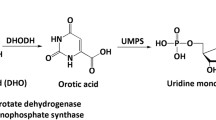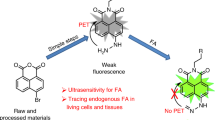Summary
Glyoxylic acid vapour is a most powerful reagent for the fluorescence histochemical visualization of biogenic monoamines. In the present investigation the mechanisms of fluorophore formation in the glyoxylic acid reaction has been studied in detail for tryptamine in histochemical models and in freeze-dried tissue, utilizing microspectrofluorometric, Chromatographic, and mass spectrometric techniques in combination with isotope measurements.
The glyoxylic acid-tryptamine reaction proceeds through an initial Pictet-Spengler type cyclization to 1,2,3,4-tetrahydro-β-carboline-1-carboxylic acid, followed by two alternative fluorophore forming reactions yielding 3,4-dihydro-β-carboline, or the 2-carboxymethyl-3,4-dihydro-β-carbolinium and 2-methyl-3,4-dihydro-β-carbolinium salts, which are all strongly fluorescent. It is shown that the yield of fluorophores is considerably higher in the glyoxylic acid vapour reaction than in the formaldehyde vapour reaction of the standard Falck-Hillarp method, and that this higher efficiency of glyoxylic acid is due to the most favourable catalysing properties of the carboxylic group of the glyoxylic acid molecule.
Similar content being viewed by others
References
Axelssoll, S., Björklund, A., Falck, B., Lindvall, O., Svensson, L. Å.: Glyoxylic acid condensation: a new fluorescence method for the histochemical demonstration of biogenic monoamines. Acta physiol. scand. (in press) (1972).
Axelsson, S., Björklund, A., Lindvall, O.: Fluorescence histochemistry of biogenic monoamines: a study of the capacity of various carbonyl compounds to form fluorophores with biogenic monoamines in gas phase reactions. J. Histochem. Cytochem. 20, 435–444 (1972a).
Axelsson, S., Björklund, A., Lindvall, O.: Glyoxylic acid spray: a new sensitive Chromatographic detection reagent for phenylethylamines and indolylethylamines. J. Chromatog. (in press) (1972b).
Björklund, A., Ehinger, B., Falck, B.: A method for differentiating dopamine from noradrenaline in tissue sections by microspectrofluorometry. J. Histochem. Cytochem. 16, 263–270 (1968).
Björklund, A., Falck, B., Håkanson, R.: Histochemical demonstration of tryptamine. Properties of the formaldehyde-induced fluorophores of tryptamine and related indole compounds in models. Acta physiol. scand. Suppl. 318 (1968).
Björklund, A., Falck, B., Håkanson, R.: Comparison of formaldehyde gas and Procházka reagents for the detection of biogenic monoamines by thin-layer chromatography. J. Chromatog. 47, 530–536 (1970).
Björklund, A., Falck, B., Owman, C.: Fluorescence microscopic and microspectrofluorometric techniques for the cellular localization and characterization of biogenic amines. In: Methods in investigative and diagnostic endocrinology, edited by J. E. Rall and I. J. Kopin. Vol. 1: The thyroid and catecholamines. Amsterdam: North-Holland Publ. Comp. 1972.
Björklund, A., Falck, B., Lindvall, O., Svensson, L.-Å.: New aspects on reaction mechanisms in the formaldehyde histofluorescence method for monoamines. J. Histochem. Cytochem. (in press) (1972).
Björklund, A., Lindvall, O., Svensson, L.-Å.: Histochemical visualization of melatonin. (To be published) (1972).
Björklund, A., Nobin, A., Stenevi, U.: Acid catalysis of the formaldehyde condensation reaction for a sensitive histochemical demonstration of tryptamines and 3-methoxylated phenylethylamines. 2. Characterization of amine fluorophores and application to tissues. J. Histochem. Cytochem. 19, 286–298 (1971).
Björklund, A., Stenevi, U.: Acid catalysis of the formaldehyde condensation reaction for sensitive histochemical demonstration of tryptamines and 3-methoxylated phenylethylamines. 1. Model experiments. J. Histochem. Cytochem. 18, 794–802 (1970).
Corrodi, H., Hillarp, N.-Å.: Fluoreszenzmethoden zur histochemischen Sichtbarmachung von Monoaminen. 2. Identifizierung des fluoreszierenden Produktes aus Dopamin und Formaldehyd. Helv. chim. Acta 47, 911–918 (1964).
Corrodi, H., Jonsson, G.: Fluoreszenzmethoden zur histochemischen Sichtbarmachung von Monoaminen. 5. Identifizierung des fluoreszierenden Produktes aus Modellversuchen mit 5-Methoxytryptamine und Formaldehyd. Acta histochem. Jena 22, 247–258 (1965).
Corrodi, H., Jonsson, G.: The formaldehyde fluorescence method for the histochemical demonstration of biogenic monoamines. A review on the methodology. J. Histochem. Cytochem. 15, 65–78 (1967).
Falck, B.: Observations on the possibilities of the cellular localization of monoamines by a fluorescence method. Acta physiol. scand., Suppl. 197 (1962).
Falck, B., Hillarp, N.-Å., Thieme, G., Torp, A.: Fluorescence of catecholamines and related compounds condensed with formaldehyde. J. Histochem. Cytochem. 10, 348–354 (1962).
Gupta, R. N., Spenser, I. D.: 3,4-Dihydro-β-carbolines. II. The exhaustive methylation of 3,4-dihydro-β-carboline. Canad. J. Chem. 40, 2049–2056 (1962).
Hamberger, B.: Reserpine-resistant uptake of catecholamines in isolated tissues of the rat. Acta physiol. scand., Suppl. 295 (1967).
Pachter, I. J., Mohrbacher, R. J., Zacharias, D. E.: The chemistry of hortiamine and 6-methoxyrhetsinine. J. Amer. chem. Soc. 83, 635–642 (1961).
Ritzén, M.: Quantitative fluorescence microspectrophotometry of catecholamine-formaldehyde products. Model experiments. Exp. Cell Res. 44, 505–520 (1966).
Roberts, J. D., Caserio, M. C.: Basic principles of organic chemistry. New York and Amsterdam: W. A. Benjamin, Inc. 1965.
Schöpf, C., Steuer, H.: Biogenesis of rutecarpine and evodiamine. Synthesis of rutecarpine under physiological conditions. Ann. Chem. 558, 124–136 (1947).
Seiler, N., Wiechmann, M.: Die fluorimetrische Bestimmung des Mezcalins und einiger β-Phenäthylamine. Hoppe-Seylers Z. physiol. Chem. 337, 229–240 (1964).
Svensson, L. Å.: A new reaction in histochemistry: Structure and mechanism of formation of fluorescent compounds in the reaction of tryptamine and carboxyl substituted tetrahydro-β-carbolines with glyoxylic acid. Experientia (Basel) (in press) (1972).
Tschesche, R., Jenssen, H.: Untersuchungen an 3,4-Dihydro-2-carbolin-carbonsäuren-(3). Chem. Ber. 93, 271–280 (1960).
Vejdělek, Z. J., Trčka, V., Protiva, M.: Synthetic experiments in the group of hypotensive alkaloids-XXI. Chemistry of 1,2,3,4-tetrahydronorharmane-1-carboxylic acid and derivatives. J. med. pharm. Chem. 3, 427–440 (1961).
Whaley, W. M., Govindachari, T. R.: The Pictet-Spengler synthesis of tetrahydroisoquinolines and related compounds. In: Organic reactions, edited by R. Adams, p. 151–206. New York: John Wiley and Sons, Inc. 1951.
Author information
Authors and Affiliations
Rights and permissions
About this article
Cite this article
Björklund, A., Lindvall, O. & Svensson, LÅ. Mechanisms of fluorophore formation in the histochemical glyoxylic acid method for monoamines. Histochemie 32, 113–131 (1972). https://doi.org/10.1007/BF00303727
Received:
Issue Date:
DOI: https://doi.org/10.1007/BF00303727




